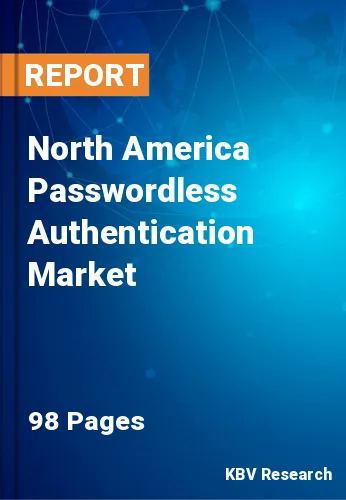The North America Passwordless Authentication Market would witness market growth of 17.3% CAGR during the forecast period (2022-2028).
Due to modern AI, it is now possible to fake some physical characteristics, but it is still exceedingly difficult to fake behavioral characteristics. In passwordless authentication systems, a person can also be identified by an item they are carrying. This method of authentication is known as possession authentication. Examples include a hardware token, an SMS-delivered OTP, or a code generated by an authenticator software.
Consequently, magic links can be used as well. After entering their email address, the user receives an email from the system. The email contains a link that, when clicked, grants access to the user. The increased adoption of passwordless authentication methods is a consequence of the unreliability of traditional passwords. Additionally, human factors like opting for easy passwords or forgetting them altogether have motivated many companies to implement passwordless verification systems.
In recent years, the cost of utilizing traditional passwords has grown as these are highly insecure and easily hackable. As such, its negatives easily outweigh the benefits. Password limitations are often not respected by users, and even the toughest passwords are vulnerable to attacks and easily used in phishing scams.
In America, the Bank of America changed its online bill pay service and removed the existing one-time password two-factor authentication (OTP 2FA) system. The new authentication system implemented by the bank sends a notification for authentication through text or email. Presently, this system, called SafePass, is only applicable to transactions of a high order. Passwordless authentication is also used by the Department of Homeland Security (DHS) of America. The department uses biometrics to identify and prevent illegal entry into the nation. Therefore, in the coming years, the passwordless authentication market will grow exponentially in the region as a result of the implementation of these systems in government facilities and higher adoption of the technology in general by consumers.
The US market dominated the North America Passwordless Authentication Market by Country in 2021; thereby, achieving a market value of $9,836.9 million by 2028. The Canada market is experiencing a CAGR of 19.9% during (2022 - 2028). Additionally, The Mexico market would exhibit a CAGR of 18.9% during (2022 - 2028).
Based on Product Type, the market is segmented into Fingerprint Authentication, Palm Recognition, Iris Recognition, Face Recognition, Voice Recognition, Smart Card, and Others. Based on Component, the market is segmented into Hardware, Software, and Services. Based on Authentication Type, the market is segmented into Single-factor and Multi-factor. Based on Portability, the market is segmented into Fixed and Mobile. Based on End User, the market is segmented into Government, BFSI, IT & Telecom, Retail, Transportation & Logistics, Healthcare, Aerospace & Defense, and Others. Based on countries, the market is segmented into U.S., Mexico, Canada, and Rest of North America.
Free Valuable Insights: The Global Passwordless Authentication Market is Predict to reach $37.1 Billion by 2028, at a CAGR of 18%
The market research report covers the analysis of key stake holders of the market. Key companies profiled in the report include Assa Abloy AB, Dermalog Identification Systems Gmbh, East Shore Technology, LLC, Fujitsu Limited, M2SYS Technology, Inc., Microsoft Corporation, NEC Corporation, Okta, Inc. and Thales Group S.A.
By Product Type
By Component
By Authentication Type
By Portability
By End User
By Country
Our team of dedicated experts can provide you with attractive expansion opportunities for your business.

